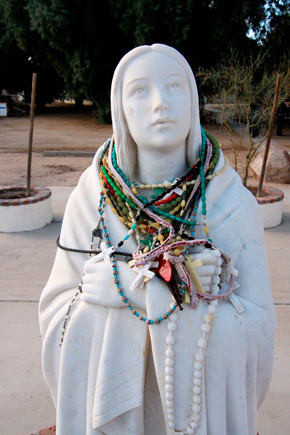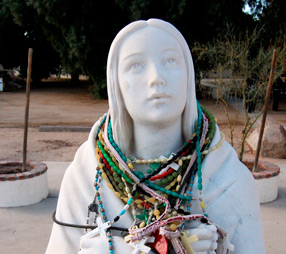Pope Benedict XVI in Rome will canonize blessed Kateri Tekakwitha, a 17th century Mohawk Indian woman, Oct. 21. An iconic figure of faith long revered by Native Americans and others, Tekakwitha will be the first Native woman to be canonized.

Deacon Jim Trant, who has worked among the Native peoples for more than 40 years and is parish life coordinator for Native American missions in the Diocese of Phoenix, lauded Blessed Kateri’s devotion to the Eucharist.
“I think it’s going to be just a wonderful, especially for young Native Americans to have a saint of her young age that they can use as a role model to emulate,” Deacon Trant said. “She was very much dedicated to the Eucharist. She was an evangelist among her people, spreading the faith, especially among the women in the villages she lived in.”
Herman Ray, a Pima Indian who lives in Salt River, just east of Scottsdale, credits Tekakwitha with saving his life. He said that in 2007 he was at the end of his rope, battling addictions to alcohol and crack cocaine.
“I cried out to God and said, ‘I don’t want to die. I know You gave me my life and I don’t want to die and go to hell.’ I felt like I was in a pit,” Ray said. “He heard my cry. And He sent Kateri into the pit to help me out.”
Without counseling or a rehab program, Ray said he was able to escape the bonds of addiction, something he thinks was a miracle due to Blessed Kateri’s intercession. A few days after his heartfelt prayer, Ray’s mother invited him to attend the national Kateria Tekakwitha conference in Washington, D.C.
“On the last day, they had a Mass at the Basilica of Immaculate Conception. I went into this big huge church and there was a statue there of Kateri,” Ray said. “I heard drums and Native singing, saw the smoke blessing with eagle feathers, people dressed in their regalia. It showed me that I could be a Native and have my traditions and also be a Catholic. To combine those two together makes me strong as a native and a Catholic.”
Since then, Ray said he’s had a strong desire to be in church frequently and to spread devotion to Blessed Kateri, telling others how she saved his life and that she is a bridge between Natives and non-Natives in Catholicism.
“She was a true Native to her people, but she had the most devotion to the Lord,” Ray said. “In that way, she shows Natives that you can be a Native as God created you, but you can also be a Catholic in the way God wants you to worship Him.”
Cathy Vasquez, who belongs to the Tono O’Odham tribe, is in charge of the Inter-Tribal Kateri Circle and is also an elected Board Member for the National Tekakwitha Conference. She’s been involved with the Phoenix Kateri Circle since she graduated from Northern Arizona State University. The group spreads devotion to Blessed Kateri meets monthly to pray and recite the rosary.
“During that era when [Blessed Kateri] grew up, for many tribes Catholicism was forbidden. Even her own family wanted to exile her,” Vasquez said. “To maintain that devotion and faith in Our Lord no matter how much pressure you might experience is inspiring.”
Blessed Kateri’s canonization, Vasquez said, shows that “Natives can maintain their culture while continuing our faith and our devotion.”
Both Ray and Vasquez plan to attend the canonization ceremony in Rome.
Phoenix Catholic Marlene McCauley, who is not a Native American, has long been devoted to Blessed Kateri, too. McCauley, author of “Adventures with a Saint: Kateri Tekakwitha, Lily of the Mohawks,” is enthused about the upcoming canonization.
“They’ve waited a long time — it was over 300 years ago that she was born,” McCauley said. “She will bring to them new life in their faith and loving Jesus in the holy cross and in the Eucharist.”
McCauley also lauded Blessed Kateri as someone modern-day Catholics could emulate. “She will be a model for their youth because she lived a life of purity and a burning love of God. This is what we need and what they need,” McCauley said. “It’s the most wonderful thing that could happen.”
Kateri Tekakwitha was born in modern-day upstate New York to a Mohawk war chief and Christian Algonquin mother. Her village was struck by smallpox, killing both her mother and brother and leaving her deeply scarred and with severe damage to her vision.
Baptized at age 20, fellow tribe members and even her family ostracized her, especially after she vowed to never marry. According to those who knew her, she lived a life of heroic virtue and prayer. She received threats to her life and eventually moved to a Christian mission near Montreal where she died a year later at age 24.
Blessed Kateri’s intercession is credited with healing Jacob Finkbonner, a 5-year-old Native boy from Washington, who in 2006 was near death, suffering from a life-threatening, flesh-eating bacteria after he split his lip playing baseball.
“Sr. Kateri [Mitchell] from the national conference was in the Seattle area and went to his bedside after he received the last rites,” Vasquez said. “She arrived with Kateri’s relics and they prayed over him.” Finkbonner was healed and his cure marked the second required miracle for canonization of Kateri Tekakwitha.






